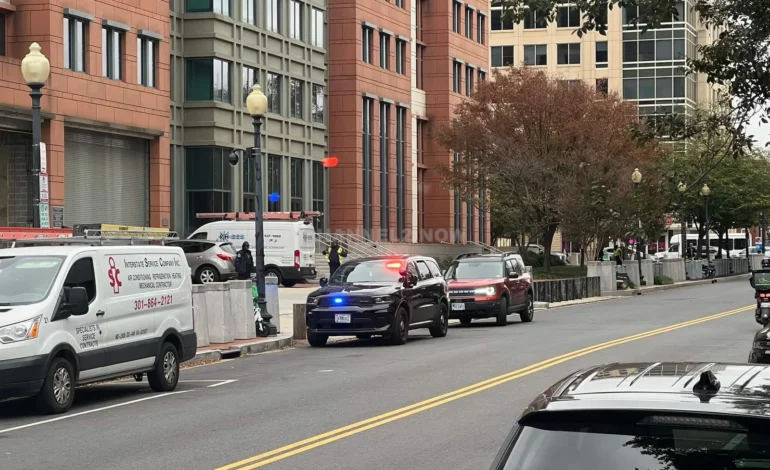
Inert Grenade Discovered in Navy Yard Prompts Evacuation Near Department of Transportation and Starbucks: Washington, DC Authorities Secure Area as Police and Emergency Responders Confirm No Active Shooter Threat
Inert Grenade Discovered in Navy Yard Prompts Evacuation Near Department of Transportation and Starbucks: Washington, DC Authorities Secure Area as Police and Emergency Responders Confirm No Active Shooter Threat; Public Advised to Remain Alert and Avoid Vicinity While Law Enforcement Conducts Thorough Investigation
Washington, DC — On the morning of November 13, 2024, an unusual and concerning event unfolded in the Navy Yard area of Washington, DC, as an inert grenade was discovered in a building at the intersection of New Jersey Avenue SE and M Street SE. The discovery triggered a swift response from law enforcement, leading to a temporary evacuation of the building and nearby areas to ensure public safety. The incident has sparked significant interest, given the high-security nature of the Navy Yard district, which houses multiple federal buildings and commercial properties frequented by government employees and the public.
Initial Discovery and Immediate Evacuation Response
The incident began when an employee working in the building reportedly noticed a suspicious object resembling a grenade. The object was located within a tenant office space in the lower floors, though the exact details of how it was discovered have not been released. Recognizing the potential danger of an explosive device, the employee immediately contacted building security, who then alerted local law enforcement and emergency services. Within minutes, officers from the DC Metropolitan Police Department (MPD) and bomb squad units arrived on the scene to assess the potential threat.
The presence of an object that appeared to be a grenade led to a rapid and coordinated evacuation of the building as a precaution. Employees working on various floors, along with visiting members of the public, were instructed to leave the premises immediately. Evacuation protocols were enforced across nearby buildings as well, with local businesses, including the prominent Starbucks located on the ground level, shutting down temporarily. Additional precautions were taken to cordon off a wide radius around the building, preventing pedestrian and vehicular traffic from approaching while emergency teams secured the area.
Emergency Response and Confirmed Nature of the Device
As law enforcement and bomb squad teams worked to assess the object, initial fears revolved around the potential for an explosive device in an area that houses government and commercial offices, including the Department of Transportation headquarters. Bomb squad specialists carefully examined the grenade-like object and conducted several tests to determine its risk level. Around mid-morning, authorities confirmed that the grenade was inert, meaning it was not capable of exploding. This finding allowed officials to rule out an imminent danger to the public, but they continued to treat the situation with caution until a thorough sweep of the area was completed.
Despite the grenade being classified as inert, the presence of such an object in a high-security area raised concerns among local law enforcement and city officials. Authorities are actively investigating how the device ended up in the building and whether any protocols had been breached in terms of screening and securing suspicious objects. Officials from the MPD, in cooperation with federal agencies, have initiated a probe to understand the origin of the grenade and whether it was left as a prank, abandoned by mistake, or placed deliberately.
Public Communication and Community Impact
In the hours following the discovery, DC Metropolitan Police issued multiple public alerts through social media and official channels to keep the community informed. Notifications reassured the public that there was no active shooter, dispelling initial fears fueled by the large police presence. Authorities stressed that the situation was under control and urged individuals to avoid the area and comply with evacuation orders if already on-site.
Many local residents and office employees expressed both concern and relief. The DC Metro area is accustomed to high-security alerts due to its proximity to federal institutions, yet each incident evokes significant anxiety due to the potential implications of such events. As crowds gathered at safe distances, bystanders discussed the situation with a mixture of curiosity and unease. Business owners in the Navy Yard neighborhood also expressed frustration with the temporary closures, noting that even short disruptions have economic repercussions, particularly for small businesses that rely on daily foot traffic from employees and visitors.
Background on the Navy Yard District and Security Sensitivities
The Navy Yard area is one of Washington, DC’s most dynamic neighborhoods, featuring a blend of government facilities, commercial establishments, and residential buildings. The district’s strategic importance stems from its close proximity to Capitol Hill, the Washington Navy Yard, and various federal agencies, including the Department of Transportation. The area is a hub for both federal employees and civilians, with amenities like cafes, restaurants, and recreational areas drawing residents and tourists alike.
Given the district’s significance, security is a top priority. Buildings in the area are subject to strict screening measures, and law enforcement presence is generally high. The discovery of an inert grenade in this setting raised questions about potential gaps in security and sparked conversations about the need for vigilant safety protocols. Incidents in sensitive areas such as the Navy Yard are not taken lightly, especially given the heightened security climate in the capital due to recent high-profile incidents involving public safety.
Details on the Inert Grenade and Safety Procedures Followed
While authorities have yet to release specific details on the grenade’s appearance or how long it may have been in the building, experts familiar with inert explosives note that such devices often resemble live grenades in structure but lack the explosive materials or fuse components necessary for detonation. In some cases, inert grenades are used for training purposes or as collectibles, but their presence in public areas, particularly federal office buildings, is usually restricted.
The MPD’s bomb squad, along with federal explosive experts, followed standard protocol in handling the device. After an initial visual inspection, they used remote techniques to confirm its inert status, a method that minimizes risk to personnel. Once it was deemed safe, officers removed the grenade from the building and transported it to a secure facility for further analysis.
While the device posed no direct danger, the protocol observed serves as a reminder of the importance of emergency readiness. Law enforcement emphasized that any object suspected of being an explosive should be reported immediately, and they urged the public not to approach or attempt to handle suspicious items, even if they appear inactive.
Investigation into Possible Security Breaches and Origins of the Device
With the immediate threat contained, the focus now shifts to understanding how an inert grenade came to be located within a secure building in one of Washington’s most guarded districts. Investigators are examining surveillance footage from entry points and elevators, aiming to identify any unusual activities or persons who may have brought the device inside. They are also conducting interviews with building staff and employees to determine whether anyone observed suspicious behavior leading up to the discovery.
The MPD and federal partners are considering several possible explanations for the device’s presence, including whether it was part of a security training exercise, misplaced by a civilian employee, or deliberately placed to provoke a reaction. Officials are also exploring the possibility that the grenade could have been part of a personal collection inadvertently brought into the building by an employee or visitor.
Public Reactions and Social Media Response
The incident attracted attention both locally and nationally, with residents and workers in the DC area turning to social media for updates and sharing their experiences. Some expressed frustration over the disruption, questioning how a grenade-like object could make it into a high-security facility. Others voiced gratitude for the quick response from law enforcement, acknowledging the challenge of balancing public safety with minimal disruption in a city that frequently deals with security concerns.
Local social media groups dedicated to Navy Yard residents provided a platform for real-time information, with individuals sharing eyewitness accounts and posting photos of the police cordons and emergency vehicles in the area. The swift and coordinated police response was generally praised, though some voiced concerns about the frequency of security alerts and potential vulnerabilities in DC’s highly populated federal zones.
Impact on Local Businesses and Area Routine
With numerous businesses in close proximity, including restaurants, retail shops, and corporate offices, the evacuation had a pronounced impact on the local economy for the day. Many businesses faced temporary closures, while others saw reduced foot traffic due to the area’s restricted access. The popular Starbucks on M Street, a favored spot for both government employees and locals, was closed for most of the day. Nearby eateries and retailers also experienced interruptions, with some estimating a loss in revenue from missed lunch-hour customers and reduced afternoon activity.
Local business owners expressed hope that increased awareness of security procedures would help prevent future incidents and that emergency responses would be optimized to minimize economic impacts. The DC Chamber of Commerce issued a statement thanking law enforcement for their handling of the situation and encouraging businesses to remain vigilant about security risks.
Increased Awareness and Precautionary Measures
In light of the incident, city officials have reiterated the importance of vigilance and safety preparedness for DC residents, government employees, and visitors. The MPD is expected to review its safety protocols and may increase training efforts aimed at building staff to recognize and report suspicious objects. Additionally, the Department of Homeland Security, in collaboration with local agencies, has announced plans to conduct security audits in key areas to ensure that safety measures are up to date and robust.
Authorities are urging the public to continue their support by promptly reporting any unusual activity and following evacuation instructions in the event of an emergency. MPD Chief Robert Contee stressed the importance of community cooperation in safeguarding the city, underscoring that public awareness and adherence to safety protocols can make a significant difference in managing incidents effectively.
Conclusion: A Resilient Community and Ongoing Safety Measures
While the incident ended without injury or damage, it serves as a reminder of the potential for disruption even in highly secured areas. Residents and employees in the Navy Yard area have expressed appreciation for the professionalism and urgency shown by local law enforcement. As the investigation into the inert grenade’s origins continues, DC authorities remain committed to reinforcing the city’s security measures and fostering a resilient, well-prepared community.
This incident has prompted calls for increased focus on security training and awareness, especially in mixed-use federal and commercial spaces where thousands of employees, residents, and visitors interact daily. The community’s prompt response, law enforcement’s swift action, and the cooperation of affected businesses underscore Washington



